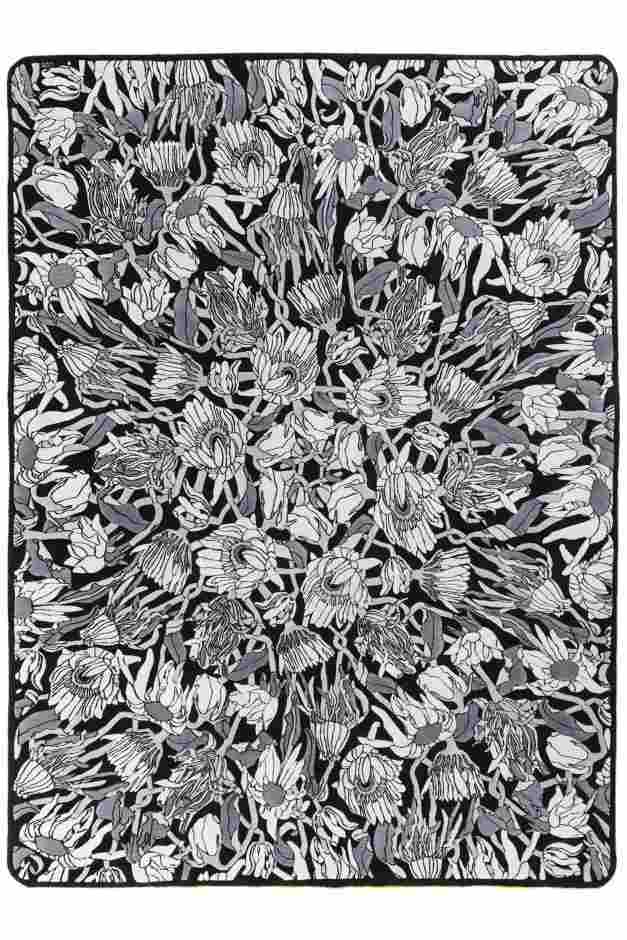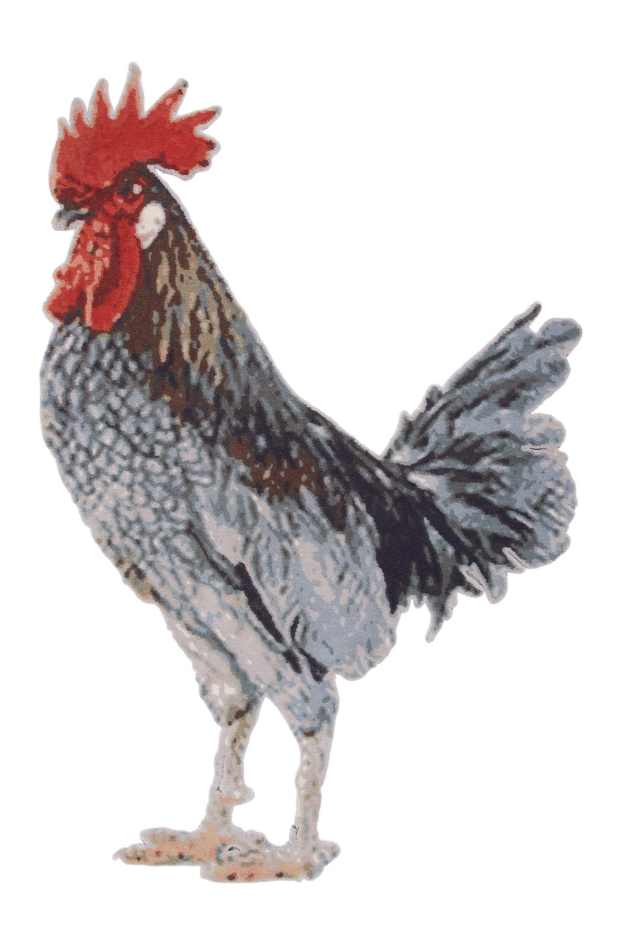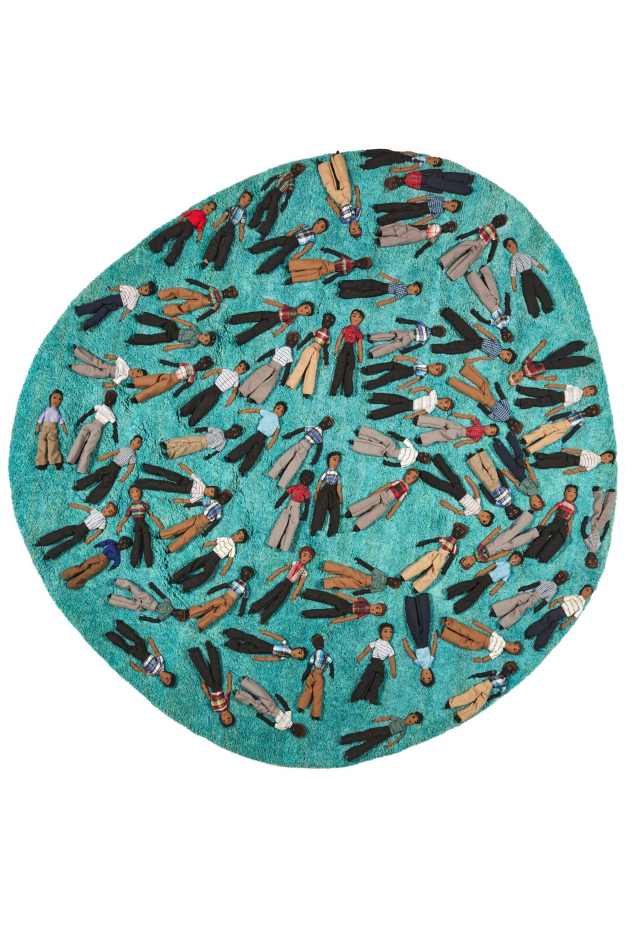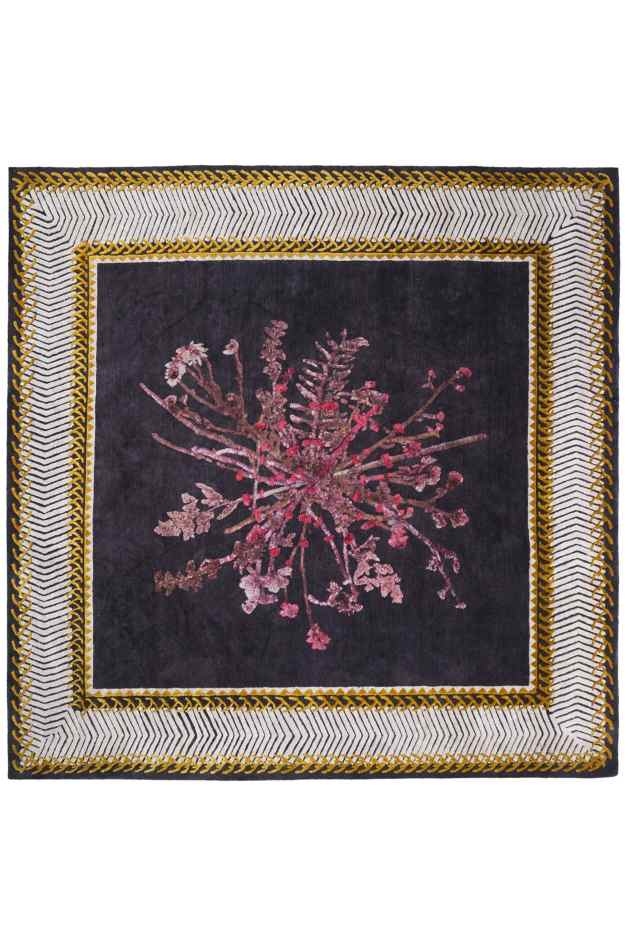Contemporary art rugs: how are they made? When should they be used? Complete guide
Design — Luxury rugs — Nov 13.2025
Contemporary art rugs are undoubtedly one of the most fascinating developments in international design in recent decades.
Once considered a functional or decorative element, the rug has become a means of expression in its own right, now capable of conveying complex artistic visions, engaging with the cultural movements of our time and occupying a conceptual space that goes far beyond simply covering a floor.
This metamorphosis did not happen overnight. It is the result of a process that has seen the growing interest of artists and designers in the textile arts converge. There has also been an evolution in production techniques, which has made it possible to translate complex creative visions with increasing fidelity. Finally, we can mention the change in the cultural perception of what can be considered “art” in the contemporary context.
Where did the idea of contemporary art carpets come from?

The history of contemporary art carpets has its roots in the Bauhaus movement and the avant-garde of the early 20th century. Artists such as Paul Klee, Wassily Kandinsky and Sonia Delaunay began to take an interest in the expressive possibilities of the applied arts, blurring the boundaries between “high” art and functional design.
However, it was in the 1960s and 1970s that the carpet definitively emerged as an autonomous artistic medium, thanks to the pioneering work of artists who used textile techniques to create installations and conceptual works.
This genesis paved the way for the extraordinary flowering of creativity that characterises the current landscape, where carpets inspired by contemporary art are no longer relegated to an experimental niche but occupy a central place in the most prestigious design collections and in the specifications of the most ambitious architectural projects.
Today, when we talk about contemporary art rugs, we are referring to luxury rugs that have specific distinctive characteristics. First and foremost is artistic intensity. In fact, these artefacts are born from a precise creative concept, from a vision that the artist (or designer) wants to communicate through their piece. These are not pleasant decorative patterns devoid of content, but visual statements that can explore abstract themes, conceptual narratives, formal experiments or journeys into the very nature of colour, texture and matter.
Secondly, these artefacts make innovation a visual language. What does this mean? Carpets influenced by contemporary art reject decorative clichés and seek new forms of expression. They draw on modern art, architecture, graphics, photography and (even!) science and technology.
Perhaps the most significant aspect of contemporary art rugs is their ability to transform the perception of architectural spaces. While a traditional rug, however beautiful, tends to blend into the existing environment, a contemporary art rug has the power to redefine the space in which it is placed. It can therefore become the visual focal point around which the entire environment is organised, creating dynamic tensions with the surrounding architecture or even destabilising established perceptions.
For architects, this transformative capacity is very valuable. This is because it allows them to add layers of complexity and meaning to a project without making structural changes. It also helps to change the interpretation of a location by introducing a powerful artistic element.
Are you looking for a rug that combines art and design?
Nodus invented the contemporary art rug.

What are the visual languages of contemporary art rugs?
Contemporary art rugs do not exist in a cultural vacuum, but interact with the aesthetic movements, artistic trends and cultural sensibilities of our time.
Understanding these visual languages and their conceptual roots allows architects to use these luxury rugs as components that contribute to the overall narrative of an interior design project.
Geometric abstraction is perhaps the most widespread language in these artefacts. Inheriting the lessons of modernism and abstract art of the 20th century, many modern designers work with pure forms, modular repetitions, and compositions based on mathematical grids or complex geometric principles. This gives rise to rugs that speak a language of rationality and order. At other times, the artefacts destabilise the language through intentional anomalies, subtle asymmetries or the use of colour in ways that contradict the geometric coldness.
Some examples? A carpet featuring a perfect grid of squares in which each element has a slightly different colour gradation from the others, creating a visual vibration effect. A piece like this is significant in how geometric abstraction in contemporary art carpets can be both rigorous and poetic.
Another important trend that has contributed to the emergence of this textile art? Minimalism has found a very interesting expression in contemporary art carpets. Some of the most powerful pieces are those that forego any decoration, working only with texture, materials and colour. A 100% monochromatic rug, in which the visual interest derives solely from variations in pile height and differently worked areas that capture and reflect light in different ways, is a perfect example of how minimalism in rugs can be widely accepted. And this is despite the absence of conventional decorative elements. These artefacts require a certain visual sophistication to be fully appreciated, but for those with that sensitivity, they are the height of refinement!
That’s not all. Deconstruction and textile postmodernism emerge in carpets that play with conventions. What does that mean? There are designers who take traditional Persian or Caucasian patterns and fragment and reassemble them in impossible ways. In other cases, they superimpose them on contemporary grids. In both cases, they operate in the realm of the postmodern. Specifically, these creations comment on the history of textile design while transcending it, giving rise to objects that are both rooted in tradition and innovative.

There is often a conceptual, almost intellectual element to these works: they require the observer to recognise the references in order to fully appreciate the subversion. Abstract expressionism has influenced a whole trend of carpets characterised by compositions that resemble brushstrokes.
Splashes of colour, liquid shades, overlaps that evoke painting techniques: these artefacts bring the energy of American action painting to textiles. They are pieces that introduce movement and drama to spaces. And they are effective in otherwise very controlled and minimalist environments. So much so that these contemporary art rugs can function as real points of visual energy.
Digital technology represents one of the most recent frontiers. There are designers who work with patterns that resemble the digital distortions typical of screens. Or they work with patterns that incorporate QR codes or elements of digital graphics. These pieces are interesting because they create a conceptual short circuit: an ancient, manual, artisanal medium that nevertheless speaks the language of the digital age. These rugs are perfect for tech offices, contemporary co-working spaces and the homes of young, culturally aware customers.
Other examples? The narrative approach characterises rugs that tell stories, incorporating stylised figurative elements and presenting scenes or compositions with characters. These pieces distance themselves from pure abstraction to embrace a narrative dimension, albeit always filtered through a contemporary sensibility. They can be surreal, poetic, ironic, political: the narrative in contemporary art rugs is always mediated by a sophisticated visual language, which distinguishes these pieces from conventional decorative representations.
For an architect working on an interior design project, understanding these visual languages is necessary for an informed selection. Some examples? A minimalist contemporary art rug will work well in a Japanese or Scandinavian interior, but may seem anonymous in a more maximalist space. Furthermore, an organic piece can soften modernist architecture, creating a productive contrast. Finally, a piece with digital aesthetic glitches will be ideal for a start-up, but completely out of place in a classic contemporary residence.
The key is always dialogue. In this sense, the best results are achieved when the contemporary art rug dialogues with the architecture, when it creates complementary or intentionally contrasting relationships, never when it is simply placed in a space without considering the context.
Are you looking for a rug that combines art and design?
Nodus invented the contemporary art rug.

The integration of contemporary art rugs into high-end interior design projects
The inclusion of contemporary art rugs in architectural projects requires a strategic approach that considers multiple dimensions: functional, aesthetic, conceptual, practical, etc.
The most sophisticated architects integrate rugs from the early stages of the concept, as they recognise their ability to contribute to the overall quality of the space.
From the point of view of characterising spaces, rugs that are comparable to contemporary works of art are very powerful design tools. For example, in residential or commercial open spaces, where physical divisions are minimised to preserve visual and light flows, these artefacts allow functional areas to be defined without barriers. To give a more specific reference, placing a large carpet under the area dedicated to conviviality defines the latter as a social space, distinguishing it from the dining area or workspace. Such characterisation is particularly valuable in contemporary design, which favours flexibility and fluidity. It is for this very reason that a contemporary art rug with a strong visual presence can anchor a composition of furniture and accessories, acting as an element around which everything else is organised.
What else can be said? From the point of view of colour and light management, contemporary art rugs offer extraordinary opportunities. In a design with a mostly neutral palette (whites, greys, natural wood tones, etc.), a piece with saturated colours can attract the eye and prevent chromatic monotony. Conversely, in spaces already rich in colour, a piece in neutral or monochromatic tones can provide an area of visual rest.

Carpets also influence how light is reflected and absorbed in spaces. What does this mean? A light-coloured, shiny carpet (e.g. silk or viscose) will reflect light, contributing to the overall brightness. On the other hand, a dark, opaque carpet will absorb it, creating a more cosy and intimate atmosphere.
Size is another critical aspect and requires special attention. Contemporary art rugs are available in sizes ranging from small pieces to monumental objects measuring over 50 square metres. The right choice is really important because a rug that is too small in a large space will look lost and fragmented, while a rug that is too large in a small space will overwhelm it. The general rule for living areas is that the rug should be large enough to accommodate at least the front legs of all the furniture that defines the individual area, thus creating a cohesive island. However, this rule can be broken to achieve specific effects. This is the case with a small, bold contemporary art rug: it can function as an art installation even in a large space, if the design concept supports it.
Bespoke customisation represents the pinnacle of design integration. The best suppliers of contemporary art rugs offer customisation services that allow architects to develop pieces for specific projects. For example, a rug can be designed to reflect graphic elements in the architecture, to echo certain colour palettes in the project, to incorporate the exact dimensions required by a particular layout, and so on.
In other words, as mentioned, these custom rugs become an integral part of the architectural concept. This is not surprising, because the opportunity to work with renowned designers or specialised creative studios opens up possibilities that are practically limitless.
Are you looking for a rug that combines art and design?
Nodus invented the contemporary art rug.

Investing in a contemporary art carpet means creating projects that stand out!
It is now clear that contemporary art carpets represent much more than functional or decorative solutions. In effect, they are cultural statements, investments in lasting beauty and components capable of transforming the perceived quality of an architectural space.
For architects and designers working on high-end projects, understanding the value of these textile artefacts and knowing how to integrate them successfully into their projects is not optional. It is, in fact, a fundamental skill. A skill that distinguishes excellent work from merely competent work.
In short, we can say that the evolution of the carpet as an artistic object reflects broader transformations in the way we conceive contemporary living and working spaces. We no longer live in environments where function and form are separate, where art is confined to the walls and the rest is utilitarian. The most successful contemporary interiors are systems where every element contributes to both function and aesthetics. And where the boundaries between art, design and architecture dissolve. Contemporary art rugs perfectly embody this philosophy: they are walkable art, functional surfaces and statements that communicate values and sensibilities.
In a world where much of contemporary design is dominated by mass production disguised as quality, where authenticity is increasingly rare, where compromises are the norm, a supplier such as Nodus represents a bastion of excellence without hesitation. For those looking for contemporary art rugs that truly live up to the highest design ambitions, the answer is clear: exploring the world of Nodus is a must, because every rug is a work of art and every collaboration is a creative partnership where quality is non-negotiable.
Nodus creates artistic rugs.
Bring luxury into your home!
>>> CONTACT US! <<<

Nodus has reinvented the luxury rug. It was the first brand to propose the concept of the rug as a work of contemporary art. Nodus has always created exclusive pieces that furnish the most beautiful homes in the world.
Do you want to make your home as unique as a work of art? Bring a hand-knotted rug of the highest quality and design into your everyday life! Give your family and loved ones the beauty of a dream masterpiece!
Each Nodus piece is designed by famous designers, making it recognisable and prestigious. This means that every carpet is unique: you will not find another one like it. Like all beautiful and one-of-a-kind items, a piece from the Nodus collection sets you apart and speaks to others about your taste and refinement.
CONTACT US!